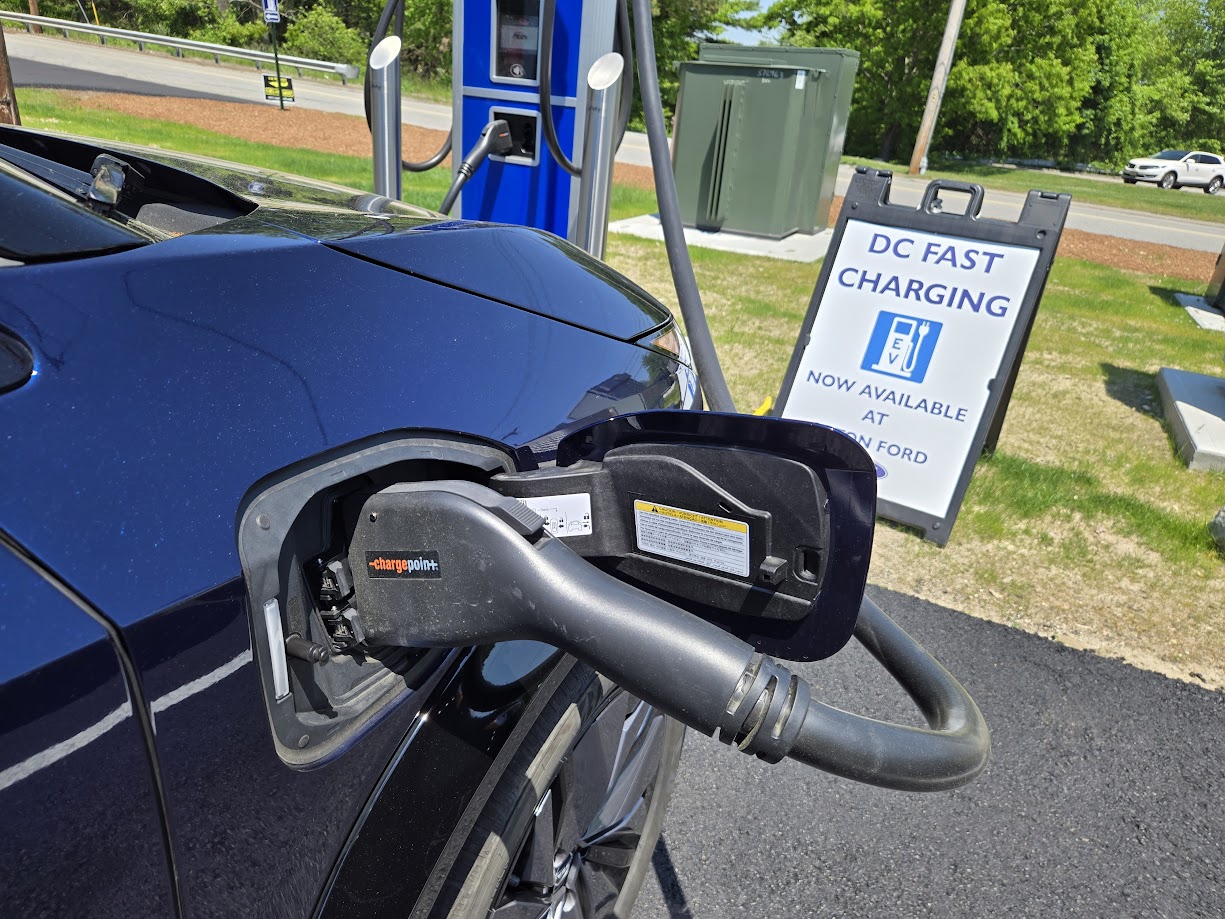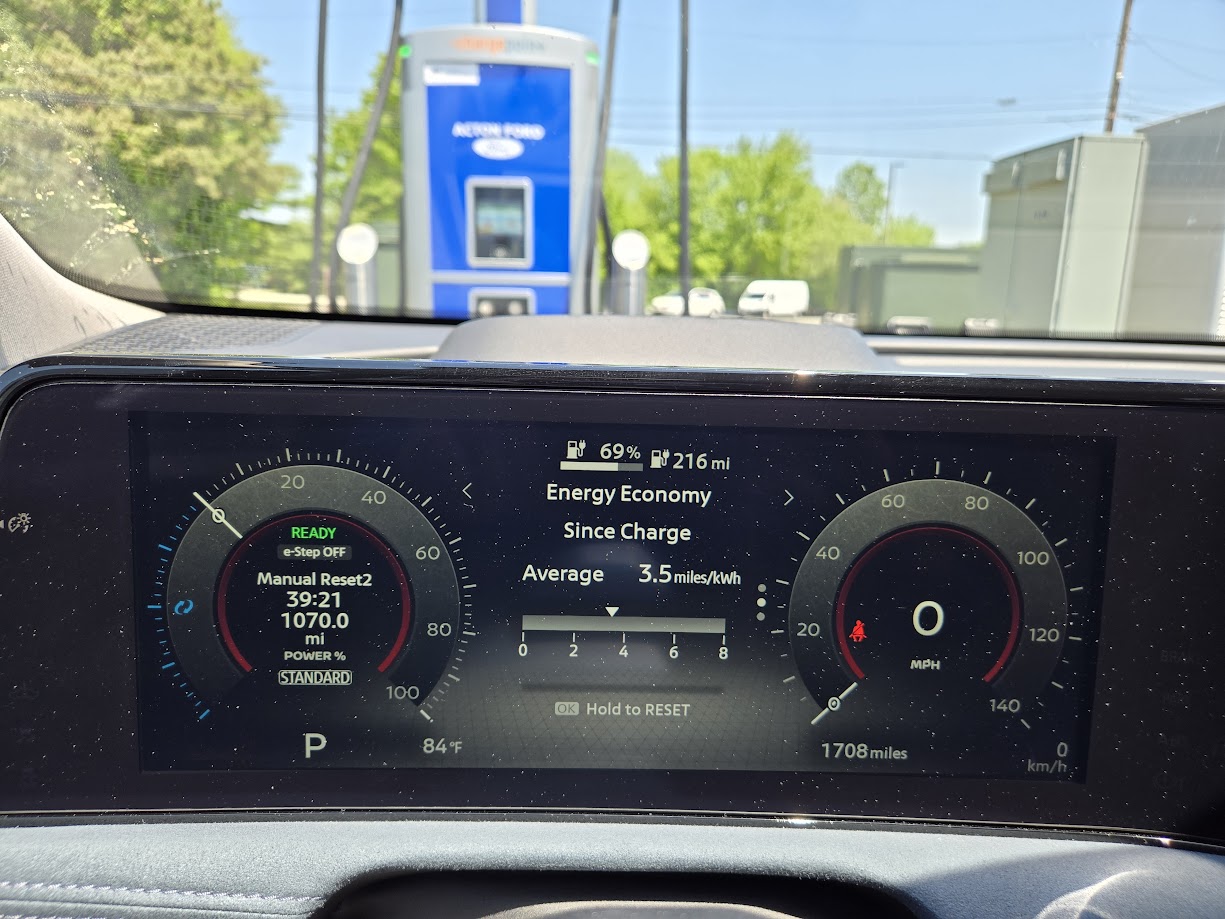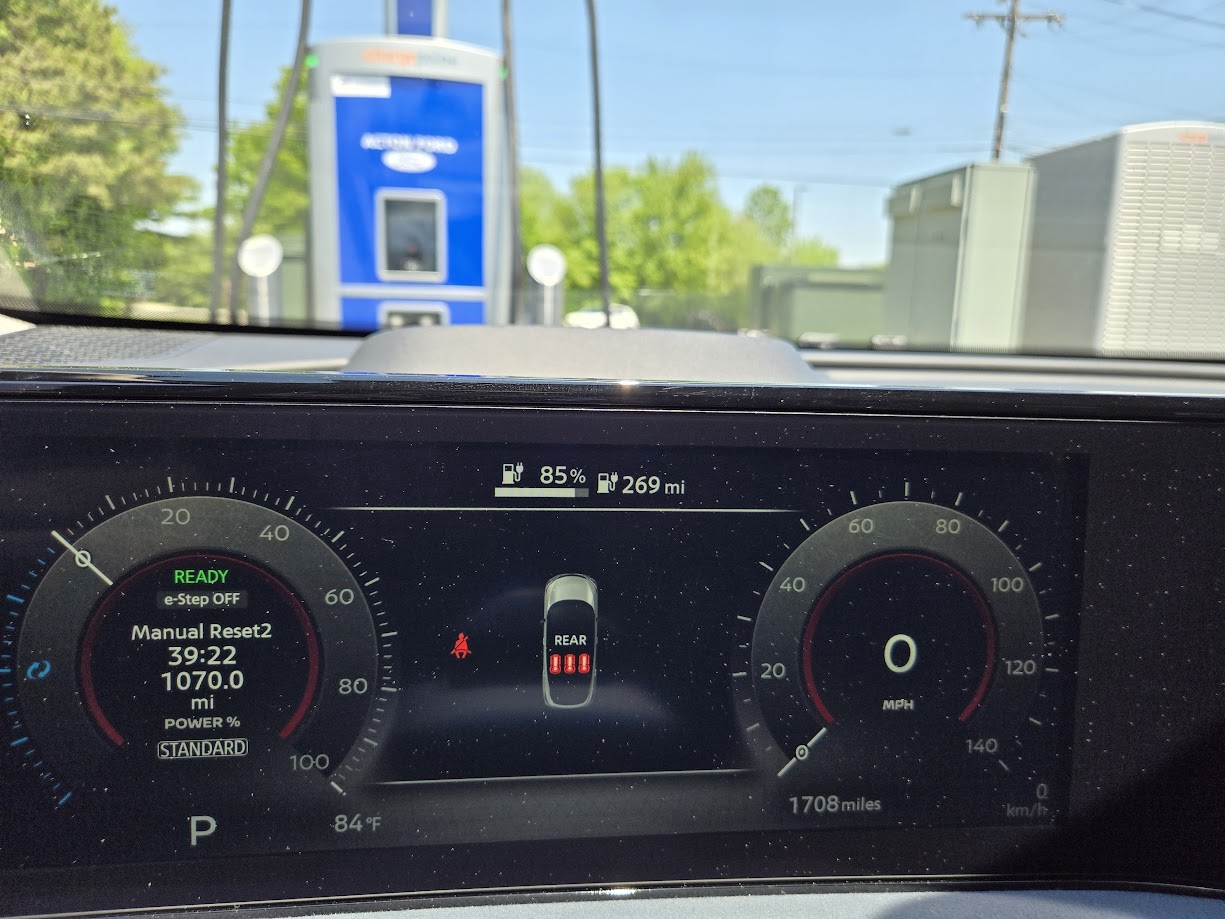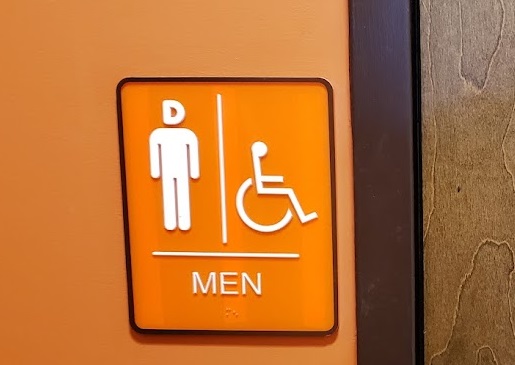May 24 - Please see the update at the end of the story.
Electric vehicle market share has leveled off at around 7% of new vehicle purchases in the United States. It’s been this way now for about five business quarters. 93% of new car buyers don’t buy EVs. One reason that is often cited for this low take rate now that EVs are piling up on dealer lots everywhere, ready for immediate delivery at steep discounts, is that public charging is a hassle. On one hand, the nEVers say that "public charging is impractical and unreliable," and on the other hand, the EVangelists say that one can energize an EV “in the same time as a bathroom break.” Both are mostly wrong, and this story won't choose a side but simply provide a real-world example of how long it takes to energize a modern battery-electric vehicle at a modern DC fast charging station.
Here is a summary of our findings explained in the full text of the story:
1) DC Fast charging an EV takes dramatically longer than fueling up a hybrid with gasoline.
2) One cannot add meaningful range to an EV in the time it takes to use a restroom.
3) One cannot “fill up” an EV at a DCFC the time it takes to grab lunch.
4) Charging at a DCFC costs roughly double the cost per mile to power a hybrid with gas.

Our Test DC Fast Charging Station
We charged at Acton Ford in Metro West Boston. This dealership, from the owner to the sales and service teams, is all-in on EVs. We interviewed the owner and general manager and have spoken to multiple salespeople and service team members. These are smart folks motivated to sell EVs. The surrounding towns include some that are quite affluent and decidedly green—the kinds of towns that vote at town meetings on whether to ban gas-powered leaf blowers.
According to our best estimates, Acton Ford has just invested seven figures in adding a long line of DC Fast chargers and over a dozen Level 2 charging points. They also landscaped the area around the new chargers and paved the lot. There is a sign posted out front asking EV owners to stop in and try the public chargers, which are managed for billing purposes by both Ford and ChargePoint. The DC Fast charger we used is rated at 120 kW according to its screen, a fact we also confirmed via ChargePoint.
Our Test EV For This Example
For our DC fast charging test, we used a new 2024 Nissan Ariya Platinum + e-Force AWD crossover. It has a total consumer cost of $55,580 before dealer doc fees. The Ariya was launched last year and has only been on sale for about 15 months. It is a current-generation battery-electric vehicle, and its price puts it squarely in the luxury realm.
We like the Nissan Ariya very much. It is great to drive, with ample torque and a quick throttle response in all situations. It feels roomy, and it has a modern look inside and out. This is our second time testing an Ariya, and we like it more with every passing day. The price seems higher than what we would pay for a five-passenger crossover, but it is significantly less than the first Ariya we tested, which topped $60K.
The Ariya is not the fastest DC-charging BEV on sale today, and it is far from the slowest. With its ability to accept 130 kW of power, it falls around average. A Chevy Bolt can only accept about 50 kW, and a Hyundai Ioniq 5 can accept 350 kW of energy—if the charger can output that amount. We have yet to find one that could in our travels.

Our Charging Test
When we parked our Nissan Ariya at the ChargePoint DC station, we observed a 69% state of charge (SOC), and the car’s mileage estimator read 216 miles of range. The vehicle’s HVAC system was set to auto, and it was about 80 degrees F outside. We arrived at 12:36 pm to charge and started our time after parking and exiting the vehicle. We used our ChargePoint account and tapped the phone on the screen to begin charging. All went as it normally does, and energy began flowing almost immediately. It takes about 15 seconds for the car-to-charger handshake to happen.

Once charging was underway, we walked a couple of hundred yards to a coffee shop chain during the lunch hour period. We then used the bathroom. After we scrubbed our hands clean as a surgeon’s, we waited in line to order lunch. I opted to have a healthy, balanced meal consisting of a coconut donut and an egg and cheese sandwich on an English muffin. I also ordered a regular-sized latte. Following a short wait, I sat and ate the food and drank most of the latte. While I did so, I monitored the state of charge using the ChargePoint app. The rate of energy input seemed consistent. It did not slow down meaningfully when the car reached 80% SOC, the typical stopping point for polite public charging. In fact, the rate seemed quite fast to me since I normally charge at home on an L2 charger. When finished, I used the bathroom and washed up a second time for the purposes of this test, not because I needed to. Finally, I walked back to the charger.

Our Charge Results
When we returned to the vehicle at 12:53 pm, it was still all alone at the DC Fast chargers. No cars had been there when we arrived. This means there was no chance we received anything but the full 120 kW charge rate. The SOC had risen to 85%, and the mileage estimator had risen to 269 miles.
Here is the charging test summary:
- Time to DC Fast Charge = 17 minutes
- Battery capacity added = 15.57 kWh
- Total SOC gain = 16%
- Total Estimated Range Gain = 53 miles
- Total Cost = $ 8.56
- Cost Per mile for energy = $0.16/m (That is crazy-high, by the way)
DC Fast Charing Conclusions
Based on our real-world test, it is obvious that charging a vehicle using DC fast charging is nothing at all like fueling up a gasoline-powered green car such as a hybrid-electric vehicle. I’ve been recording the time spent at gas stations since we purchased our 2024 Venza, and the vehicle can add roughly 500 miles of range in under 4 minutes at any gas pump we opt to try. By contrast, the DC fast charger would take about 170 minutes to input that amount of range to an EV.
Another observation is that stopping to use the bathroom (twice) and have lunch is not nearly enough time to add meaningful range back to a modern battery-electric vehicle such as the Nissan Ariya. 53 miles is better than nothing, but it’s only about 1/6th of the total range of the vehicle. A good hour and a half would be needed to fill the Ariya from about 10% to about 80% state of charge. This is Nissan’s official estimate, and it matches up with our observation as well.
Faster Cars At Faster Chargers Would Be Faster
We have the Nissan Ariya this week as a media test vehicle, so we used it. However, if we had used a vehicle with a significantly faster charge time, such as the Hyundai Ioniq 5, our charge rate would not have been faster at Acton Ford’s ChargePoint DC Fast charger. That’s because the Hyundai would still only be charging at a rate of 120 kW - the maximum rate the charger can provide.
Similarly, if we had taken the Ariya to one of the mythical 350 kW DC fast chargers every EV advocate uses in every example of super-fast charging, it would not have charged meaningfully faster since it can only accept 130 kW.
Now, if we had an Ioniq 5 and had used the fastest charger possible, the charging rate would have been roughly triple the rate we charged at. Would it be as fast as using a gas pump? Not even close. Would it have added more charge while we used the bathroom and had lunch? Sure.

Conclusion
Be wary of specifications and claims by EV advocates that try to imply you can add meaningful range to a battery-electric vehicle in the time it takes to "Use the bathroom” or “Grab a quick lunch.” While under perfect circumstances, it may be possible to add meaningful range using those times, in the real world, using a modern EV and a brand-new DC Fast charger, our experience is that the amount of charge added while taking a break for lunch and to answer the call of nature is meaningless. Powering up an EV from about empty to about full takes dramatically longer than fueling a hybrid-electric vehicle. By our best estimate, one could add roughly 2,000 miles of range to a hybrid-electric vehicle in the same time it takes to add about 50 miles to an EV. One last point. Charging at a DC Fast charger is an extremely expensive way to power up a green vehicle. Our Venza, which has a nearly identical interior volume to the Ariya, costs us about nine cents per mile to fuel with gas. By contrast, the Ariya costs about sixteen cents per mile to power at a DC fast charger.
May 24, 2024 Update - Mustang Mach-E Example Starting at Low SOC
Following the publication of this story, many readers offered comments that the story seemed to cherry-pick a situation and work backward from a predetermined conclusion. Some readers felt the Ariya was a bad choice, or that the test should have been done starting with a much lower SOC.
Following publication, our contact from Acton Ford reached out and offered the following data. The vehicle charged was a 21 Mach-E Premium Standard Range. The test was run in April at 40F, and the results were recorded at two intervals. Here are the results of that charging example.
- Time to DC Fast Charge = 30 minutes
- Initial SOC = 15%
- SOC gain = 51% (SOC displayed 66%)
- Displayed Range Gain = 95 miles
The test continued, and more data was recorded. Here is the second time interval data record of that same Mustang test:
- Time to DC Fast Charge = 60 minutes
- Battery capacity added = 53 kWh
- Total SOC gain = 76% (91% displayed)
- Total Displayed Range Gain = 144 miles
- Total Cost = $ 29.15
- Cost Per mile for energy = $0.20/m
As you can see, this example, starting at a low SOC with a different brand EV, had a very similar gain of miles per minute to the example we used in our story. The cost per mile was higher. The verbal summary of the story is that in half an hour, just under 100 miles of charge were gained. In one hour, 144 miles of range were added.
If you'd like to add a comment under this story, please note that our comments section has returned and is in bold red at the bottom of the page.
John Goreham is an experienced New England Motor Press Association member and expert vehicle tester. John completed an engineering program with a focus on electric vehicles, followed by two decades of work in high-tech, biopharma, and the automotive supply chain before becoming a news contributor. In addition to his eleven years of work at Torque News, John has published thousands of articles and reviews at American news outlets. He is known for offering unfiltered opinions on vehicle topics. You can connect with John on Linkedin and follow his work at our X channel. Please note that stories carrying John's by-line are never AI-generated, but he does employ Grammarly grammar and punctuation software when proofreading.












Comments
Newer electric vehicles…
Permalink
Newer electric vehicles charge a lot faster. And most of the time during a trip, only a partial charge is needed to reach the next destination, which makes the bathroom plus food ordering synchronization time quite feasible.
Thank you, Rajean. You are…
Permalink
In reply to Newer electric vehicles… by Rejean Plow (not verified)
Thank you, Rajean. You are correct in pointing out that not all EVs charge at the same rates. That's why made sure to include the Ioniq 5 in our story. However, we chose one of the newest EVs on the market and went to brand new DCFCs that only opened a month ago. So, the technology we tested was as new as could possibly be.
You must make short trips!…
Permalink
In reply to Newer electric vehicles… by Rejean Plow (not verified)
You must make short trips! This is a very fair road test, proving what we know! EVs are great for local shopping trips but hopeless for longer trips ( two independent test gave over 3 hours longer and almost 20% more expensive than a similar gas version of same car, that included stopping for food and washroom!
Excellent point, Rejan. That…
Permalink
In reply to Newer electric vehicles… by Rejean Plow (not verified)
Excellent point, Rejan. That is why we chose the newest and fastest-charging EV on the market for our story.
It's a widely known fact…
Permalink
It's a widely known fact in the EV space that the higher SOC (state of charge) you begin at, the slower the charging typically occurs. If you would have pulled up to the supercharger at 20% SOC, then the resulting total miles gained would be MUCH more. That's why Tesla's navigation attempts to get you at the next supercharger at the lowest possible SOC so you get more charge for your time...
So, the test that TorqueNews performed isn't an optimal representation of how fast superchargers can be.
There’s a few things I’d…
Permalink
In reply to It's a widely known fact… by Bob Cooley (not verified)
There’s a few things I’d comment on here.
You achieved something like a 60kw/h charge, because you got 15kw in 17m or so. You didn’t get 120kw/h because you were at a fairly high state of charge to begin with.
For some reason you assumed you’d received a charge rate of 120kw/h which then threw out the rest of your conclusions.
But more importantly, you’re just falling into the trap of constantly comparing it to gas cars. It doesn’t really matter on the charge rates and so on. If you stop for a break, just plug it in during your break, and you get what you get. If you are at a lower state of charge, and you actually stop for lunch, say 30 minutes, in my Tesla at least, it would certainly be at least at 80% and ready to go - PLUS you don’t then have to stop and fill up at the stinking gas station after your lunch to continue your trip. They are different to each other, and you’re making yourself mad by trying to make a comparison of how the new thing works to how the old thing worked all the time.
The Ariya has a really flat…
Permalink
In reply to It's a widely known fact… by Bob Cooley (not verified)
The Ariya has a really flat charging curve. One of the fastest chargers if you start at 50%
Thank you, Bob. Very true…
Permalink
In reply to It's a widely known fact… by Bob Cooley (not verified)
Thank you, Bob. Very true. It is unfortunate that the top third or so of the battery in EVs has such limited value on road trips. To use your turn of phrase, it is widely known that Tesla certainly has the best system on the market today. We wanted to test all-new technology not from Tesla to see how it worked.
What a pathetically bad …
Permalink
What a pathetically bad "test." Did you ever stop and consider that if the car added 15.58kWh in 17 minutes, it wasn't actually charging at 120kW? This is BASIC math. The car was charged at an average rate of 55kW. And did you ever stop and consider WHY that might be? Of course you didn't. We'll, I'll tell you... You plugged in at a relatively high state of charge of 69%. NO ONE taking a road trip is going to fast charge when they're at 69%. Why would they? Do you fill your gas tank when you have 2/3 left? 99% of the time, no. Perhaps you would if you are trying to get cheap gas before you travel to a high cost area, which is rarely a consideration for EV charging.
And why would you ignore the most prevalent make of EVs in the market for this? The vast majority of Tesla's superchargers deliver 250kW, and all Teslas made in the 6+ years can take 250kW.
The real world, most common example is a Tesla hitting a 250kW supercharger with 10-20% battery. Why don't you try that test instead and then see if you can outrace it to put 50% or more back in the pack? Good luck with that.
Just for grins, I pulled up several recent charges in similar real world scenarios on recent road trips:
10 minutes, added 39% - 26 kWh
3 minutes, added 17% - 10 kWh
16 minutes, added 51% - 34 kWh
9 minutes, added 30% - 20 kWh
14 minutes, added 45% - 30 kWh
11 minutes, added 29% - 19 kWh
9 minutes, added 31% - 21 kWh
17 minutes, added 52% - 35 kWh
So... try again, because you failed.
From the picture it looked…
Permalink
In reply to What a pathetically bad … by John (not verified)
From the picture it looked like they were charging at a CPE250 which has a 62kw charge speed.
It looks like your charge…
Permalink
In reply to What a pathetically bad … by John (not verified)
It looks like your charge speeds are up to about 120kw. Basic math. How much did it slow down over 50%
Your comments are much…
Permalink
In reply to What a pathetically bad … by John (not verified)
Your comments are much appreciated. One way to summarize your point is that EV owners don't really use the top third of their battery capacity on road trips.
Wait 5-8 years. Solid state…
Permalink
Wait 5-8 years. Solid state batteries (with sodium) will charge in about 10 minutes (with a range of 1,000 miles).
But could I have one with…
Permalink
In reply to Wait 5-8 years. Solid state… by RF Shulties. (not verified)
But could I have one with 500 mile range that charges in 5 minutes and costs less instead?
And I am hoping we will see them sooner than that. Of course finishing up the last development details always take longer than anyone expects.
Current EVs are definitely just the starting point, there is much better to come in the EV world.
I'm glad you posted this RF…
Permalink
In reply to Wait 5-8 years. Solid state… by RF Shulties. (not verified)
I'm glad you posted this RF. We do hope to be here in 5-8 years to report that good news if it becomes reality. Can you imagine how massive the cables will need to be to transfer that much more energy so rapidly!? The ones at this Chargepoint station were quite heavy and very thick.
Lol I've done numerous long…
Permalink
Lol I've done numerous long distance trips in our tesla m3. Charge speeds at 250kwh. Normal stops are 15-20 min and drive 2-3 hours. I was not thinking this car would be our road trip car as we own other ICE cars but the comfort and use of autopilot makes long trips a lot more enjoyable. Stopping evert 2-3 hours really isn't much different than what we would do anyways with my wife. If we stop for a meal that's when we charge longer and just extend the next stop out. Plus still about half the cost as gas. Never had a single issue with tesla chargers being down or not where we needed one.
Plugshare comments are full…
Permalink
In reply to Lol I've done numerous long… by Jason Donegan (not verified)
Plugshare comments are full of Tesla owners complaining about broken superchargers or constantly swapping superchargers to get speeds above 50kw. I think your obser actions may indicate what you think you observe charging your car. I really doubt anyone who tries to say Public EV chargers are cheaper than gas cars because that is ridiculous.
Thank you for your post,…
Permalink
In reply to Lol I've done numerous long… by Jason Donegan (not verified)
Thank you for your post, Jason. It reinforces our point made in the story that faster charging cars, using faster chargers, do charge faster.
We buy vehicles to do things…
Permalink
We buy vehicles to do things that we rarely do. We buy a minivan because the kids sometimes have friends over. We buy the big SUV because on holiday we want the space (and towing a trailer is so last century). We buy the big 4x4 because we MAY want to go off road... some day, or because we tow a boat occasionally. And then, we take that supersized car, and we spend 95% of the time driving it short distances, and we pay the higher fuel consumption for that behemoth because we convinced ourselves that this is what we need.
Choosing a gas vehicle because you occasionally do long trips, is on that same spectrum. Perhaps unavoidable, but if we are honest with ourselves: We are literally driving around inefficient, expensive, dirty vehicles all year, because of those few times a year that we cannot possible be expected to rent a vehicle, take a different kind of transport, or wait a little while having a meal!
Having used my ‘slow…
Permalink
Having used my ‘slow charging’ Chevy Bolt for over 5 years … it’s not and never has been a problem.
I'm glad you mentioned this,…
Permalink
In reply to Having used my ‘slow… by Joshua Turcotte (not verified)
I'm glad you mentioned this, Joshua. We have published stories saying the same thing. The Bolt's 50-55kW charge rate is not a problem for the vast majority of its owners. Our polls show that most Bolt owners almost exclusively charge at home. As do we.
CATL is producing batteries…
Permalink
CATL is producing batteries that charge in 10 minutes soon to be available on Chinese EVs.
That could be a game-changer…
Permalink
In reply to CATL is producing batteries… by James Sullivan (not verified)
That could be a game-changer. When that technology arrives, it will mean that an EV can be energized from empty to full in about four times the number of minutes a hybrid can be filled with an equal range using gas. Much better tan today.
Just another anti-EV article…
Permalink
Just another anti-EV article. EV drivers know that charging speeds drop dramatically at 80%. When on long trips you drive to around 10-20% and then charge to around 80%. Just last Sunday I drove 272.5 miles and stopped to charge at 10%. I added 54.576 kWh to the car in 34 minutes. That got me to 69%, which was more than enough to get to my next stop. So I added over 180 miles in those 34 minutes (the speed limits were slower in the upcoming miles, so the efficacity was going to be higher).
Cost was $30.52 or about 17 cents a mile. Which is crazy high, but those first 272.5 miles were at 12 cents a kWh which works out to $9.828 total or 3.6 cents per mile which is crazy cheap. Total for the trip was about $56.135 or 10.3 cents per mile, which at $3.60 a gallon a car would have to get 35 MPG to match the cost. I don't know of a 35 MPG car that is as nice to drive as my Mach E.
EVs for people with driveways are a great way to go. They are dirt cheap to drive around town. On long trips, it depends. The longer the trip, the less the advantage and for my Mach E vs my old hybrid somewhere around 500 miles at current gas and electric prices is where the hybrid starts to be cheaper to fuel. At no point is the hybrid more fun to drive.
We love our Leafs. My…
Permalink
We love our Leafs. My 13year old Leaf is chugging along at 11 bars or c 85%battery capacity. I can drive anywhere in Birminghsm on one charge from our solar panels. My wife's newer 2020 Leaf Plus is amazing. It has the NMC532 million mile battery. We still get 100 to 125% range and the battery is about 96% after 41k miles. Could not be happier. That said.
If your family has multiple vehicles and you can charge at home one should be an EV. Charging an EV at home typically cost half the cost of fueling a Prius and you avoid contagious gas pumps. However, public chargers on the road might cost twice as much as fueling a Prius. When selecting an EV get one c with 2x thecrange of your daily commute. 3x for Teslas because of their exaggerations and charge limitations.
Thank you, David, we love…
Permalink
In reply to We love our Leafs. My… by David Radzieta (not verified)
Thank you, David, we love the Leaf too. Nissan has provided us with many for testing, and we feel it is an outstanding value, and perfect second car. Your Prius comments are very interesting. Maybe a Prius Plug-in solves the riddle best?
I don't know many people who…
Permalink
I don't know many people who want to drive 500 miles straight. I for one stop every 2 hours. and walk for 15 minutes. I am not a trucker. so pointing out range is meaningless to most people. I can charge my Tesla from low charge to high in 15 minutes ie 80% and get 200miles I can take alonger lunch break and go to 100% and go 300 miles if I don't speed in 30 more minutes. but again I do not like to drive for over 2 hours which is only 120 to 130 miles. so I plan accordingly. and even in my ICE cars I always filled up a half a tank. so that would have been at 250 on your car example. so be more realistic in your comparisons.
As charging is governed by…
Permalink
As charging is governed by the laws of physics the faster the charge the greater the percentage of energy incoming is emitted as waste heat, exponentially! So the tax payer gets hit for more money to subsidise this scam!
Why keep picking relatively…
Permalink
Why keep picking relatively obscure EVs with problematic charging? Charging at 120 kW, as if "faster than a Bolt" is impressive, is just an embarrassing rate. The most popular vehicle on the planet is the Tesla Model Y, which uses the largest and most reliable high-speed charge network, Tesla Superchargers. A typical road trip charge stop in a Tesla Model Y on a V3 Supercharger (which is most of them, Tesla has been deploying V3 since 2018, and even the older Superchargers are 150 kW) is 15 minutes, charging you to about 60% SoC, at 250 kW, which gets you back on the road in 15 minutes.
Yes, CCS chargers in the US tend to be slow and unreliable, that's why the US EV industry is abandoning CCS as a failure and moving to Tesla's charge standards. And it's a part of why Tesla dominates both EV sales and chargers in the US. But your choosing to use an extremely slow charger doesn't mean that EV charging is slow, but that you chose a wildly unrepresentative EV charging situation, and should perhaps try again using popular EVs and chargers that are more representative of most EV owners' experience in the real world.
I can make it simple. Before…
Permalink
I can make it simple. Before you buy an EV get AbetterRoutePlanner. I think its free for 30 days. Put in your desired vehicle and get it to plan your regular long routes. If you regularly do long trips then Tesla is really the only choice (because of battery pre-heating and supercharging speeds which are 3x better). If the model 3 or Y don't meet your other requirements then EVs aren't for you, yet.
Pagination